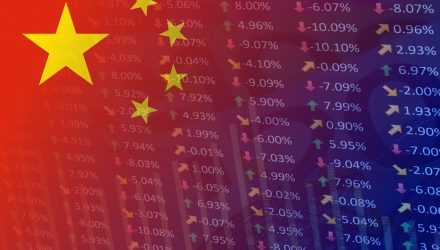In certain aspects, heading overseas for vacation purposes is a lot like investing overseas–both require a lot of planning, especially given the vast array of opportunities. That’s where the assistance of market experts like Luke Oliver, Head of U.S. ETF Capital Markets for DWS help make planning for international investing a lot simpler, particularly if you’re looking at China.
During a media call, Oliver offered his thoughts on how investors can best navigate the international markets given the number of challenges on the horizon, such as slowing global growth. Most recently, the International Monetary Fund (IMF) cut its global growth forecast to the lowest level since the financial crisis, citing the impact of tariffs and a weak outlook for most developed markets.
China Helping to Drive Global Growth
According to the IMF, the world economy will grow at a 3.3 percent pace, which is 0.2 percent lower versus the initial forecast in January. Nonetheless, strength in leading markets like the U.S. with its healthy labor market are keeping global growth afloat.
“The global picture is still fairly robust,” said Oliver during a media call.
Oliver also cited China as one of the primary reasons for sustaining global growth. Of course, it’s difficult to talk international investing to an investor without mentioning the world’s second largest economy.
A mix of Chinese stimulus measures have been providing the fodder for economic growth, such as lower taxes, no corporate tax breaks, monetary policy adjustments, and more market access for foreign companies to set up shop. All in all, Wall Street is looking at the Chinese government’s latest efforts as a plus for its economy, which makes it rife for investment.
“We all intuitively know that China will be the largest economy in the world–it’s not ‘will it be,’ it’s ‘when it will be,'” said Oliver.
In fact, China is becoming less resistant to safeguarding its businesses, which will open the pathways to more foreign investment.
“These fiscal measures that have been going in with these VAT (value-added tax) cuts, we think that’s increasing confidence in China so we definitely think there’s some good upside,” said Oliver.
Of course, Chinese equities will no doubt benefit the primary trigger event of a U.S.-China trade deal that’s still undergoing negotiations. While some analysts feel a trade deal is already priced into the U.S.capital markets, investors are hoping it could provide a surge for Chinese equities even further.
China’s government recently installed stricter regulations to prevent shadow banking, which allows consumers to obtain loans from non-banks. This dried up credit for purchases on big-ticket items, but also dampened real estate investment and infrastructure projects.
However, Oliver alludes to the benefits of this move, such as having better quality debt in China.
“We’re going to see this continued growth, but it’s going to be better quality growth in China,” said Oliver.
Best ETF Investments in China
China equities have also been the beneficiaries of index provider MSCI Inc. announcing recently that it would quadruple its weighting of large-cap Chinese shares in its benchmark indexes. In a press release, MSCI Inc. said it would increase the weight of China A shares in the MSCI Indexes by increasing the inclusion factor from 5% to 20% in three steps.
The decision came after an extensive global consultation with a large number of international institutional investors, including asset owners, asset managers, broker/dealers and other market participants worldwide. MSCI said the proposal to increase the weight of China A-shares garnered overwhelming support from investors.
One ETF to consider is the Xtrackers Harvest CSI 300 China A ETF (NYSEArca: ASHR) as a way for investors to gain exposure to China’s biggest, best and most authentic equities via the country’s A-shares. ASHR seeks investment results that track the CSI 300 Index that is designed to reflect the price fluctuation and performance of the China A-Share market.
In essence, ASHR is composed of the 300 largest and most liquid stocks in the China A-Share market, including small-cap, mid-cap, and large-cap stocks. Without a majority of its holdings in state-owned enterprises compared to other ETFs, ASHR provides a more diversified representation of gaining access to the world’s second largest economy.
“These are the stocks that are going to be reactive to China policy and China sentiment–most portfolios are missing these,” said Oliver. “It’s a really critical point because you’re missing a lot of these companies and not diversified enough in these companies.”
“A-shares give you a lot more diversification and lot of more exposure to the actual Chinese economy,” said Oliver.
For investors seeking broad-based exposure, they can look to the Xtrackers MSCI All China Equity ETF (NYSEArca: CN), which seeks investment results that correspond to the performance of the MSCI China All Shares Index. This index captures the large- and mid-capitalization representation across all China securities listed in Hong Kong, Shanghai and Shenzhen.
“China historically has been complex, vulcanized market–this product just makes it simple,” said Oliver. “When you buy this fund, you’re getting all of the Chinese companies. It’s a little bit like buying the S&P 500 for the U.S.”
For more market trends, visit ETF Trends.
